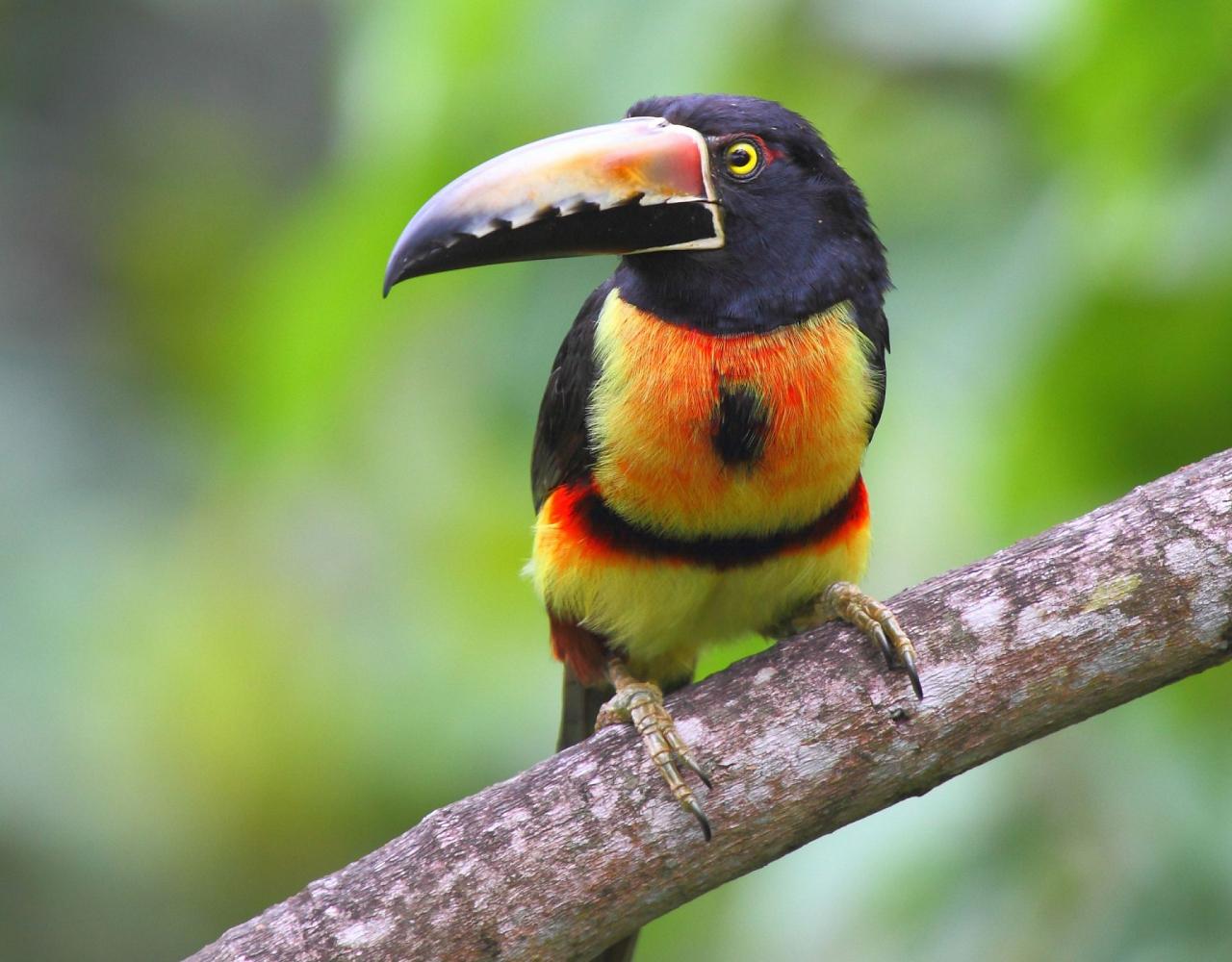Lake Yojoa, Honduras, is a biodiversity hotspot, home to a remarkable range of habitats and elevations. This scenic freshwater lake lies between two national parks, surrounded by lush mountains and teeming with life—over 500 bird species have been recorded in the area.
In its northwest corner, where limestone cliffs and forested slopes meet the water, we find Emerald Valley, a hidden gem created by Naturalist Journeys’ 2023 Guide of the Year Robert Gallardo and his wife, Olivia. Built by hand with community support, this peaceful retreat now protects nearly 80 acres of mid-elevation rainforest, forming part of a 250-acre conservation area.
Emerald Valley hosts nearly 200 bird species and an astounding 768 butterfly species—more per acre than anywhere else on Earth. Ocelots, agoutis, coatimundis, and gray foxes also call this place home.
Guests stay in hillside cabins with covered decks nestled in the forest, offering views of oropendolas, toucans, trogons, motmots, and tanagers feeding on wild fruit. Mornings begin with the calls of Little Tinamous, Chachalacas, and Laughing Falcons echoing through the trees.
This trip is designed for minimal driving and maximum discovery, with rich wildlife experiences close at hand. Robert Gallardo brings his deep knowledge as the author of both field guides to the birds and butterflies of Honduras.
Tour Highlights
- Unpack and relax once at the beautiful Emerald Valley Lodge
- Travel with the author of the Guide to the Birds of Honduras, expert Robert Gallardo whose Guide to the Butterflies of Honduras makes him your double-expert naturalist for beautiful winged creatures
- Bird and boat on Lake Yojoa, Honduras’ largest natural freshwater lake
- Explore the lush Cerro Azul Meámbar National Park, teeming with birds and also the beautiful cloud forest of Santa Barbara National Park
- Enjoy species that are easier to see here than elsewhere in their range, including Keel-billed Motmot, White-breasted Hawk, Guatemalan Screech-Owl, Great Swallow-tailed Swift and Bushy-crested Jay
Trip Itinerary
Itineraries are guidelines; variations in itinerary may occur to account for weather, road conditions, closures, etc. and to maximize your experience.
Tues., Feb. 10 Arrival into San Pedro Sula | Travel to Lake Yojoa
Welcome to Honduras! Please plan to arrive no later than 3:00 PM. You are met at the airport and go directly to Lake Yojoa. The flatlands give way to foothills and then mountains as we climb into the lake basin. Having a crater-lake appearance, the lake was, in fact, formed by volcanic action several million years ago. The lake’s surface encompasses 31square miles and we enjoy time to explore sites around this beautiful landscape during your stay.
After arriving at the village of La Union Suyapa, we switch vehicles and make the final half-mile descent into the place we call ‘Emerald Valley.’ Unpack once in the comfort of the cabin and spread out. We are received by a welcome drink and can enjoy the late afternoon from the spacious deck.
Accommodations at Emerald Valley (D)
Wed., Feb. 11 Full Day Birding & Exploring at Emerald Valley
This is your vacation! Wake up early or sleep in. Make coffee in your room or have it in the café. The cool morning air and bird sounds that echo from the surrounding forest draw you out of your room to enjoy the verdant landscape. The property sits at nearly 2,700 feet above sea level and has a comfortable temperature.
We start the day with some bird watching from one of the cabin decks. Species that can be seen include Montezuma and Chestnut-headed Oropendolas, Crimson-collared and Yellow-winged Tanagers, Spot-breasted Oriole, and Keel-billed Toucan, to name a few. Breakfast is served in the café. Afterwards, we spend the entire morning exploring a few different parts of the property. During the months of September to March, many species of migratory birds are present and we may see different wood-warblers, flycatchers, or even Wood Thrush. If we encounter a fruiting fig or mistletoe, we could possibly see Masked or Black-crowned Tityras, Northern Emerald Toucanet, Gartered Trogon, Yellow-throated Euphonia, or Buff-throated Saltator.
After enjoying a morning of bird watching, we break for lunch. Depending on everyone’s energy level and interest, we can jump right into another realm of wildlife appreciation: butterfly watching. Emerald Valley is a world-renowned and premier butterfly sanctuary. An amazing 768 species have been recorded here, including one endemic. That is more species than Canada and the lower 48 States combined, and there is nowhere else on Earth that boasts more species per acre. The actual month of the year determines which groups and species are present at any given moment. But one thing is for sure; we witness a great variety of species.
Late afternoon can be spent relaxing, wandering down side paths, or visiting one of the flower gardens. The front deck of Robert and Olivia’s house is lined with a long table and benches. It is a perfect place to sit, see, and photograph a small variety of hummingbirds that visit the Porterweed, Firebush, Heliconias, and Costa plants. More common species include White-bellied Emerald, Rufous-tailed Hummingbird, and Stripe-throated Hermit. Others that pop in on a less frequent basis include Long-billed Starthroat, Long-billed Hermit, and Blue-throated Goldentail.
Accommodations at Emerald Valley (B,L,D)
Thurs., Feb. 12 Los Naranjos Archaeological Site
Today we set out to explore a nearby archaeological site called Los Naranjos. It is named after a local coral tree (Erythrina poeppigiana) that produces large quantities of orange-colored blossoms during the brief dry season. For some time, these Lenca people were concurrent with the Mayas in Copan and belonged to an entirely different culture altogether. Studies around Lake Yojoa show that they occupied settlements up to around the 13th Century. The nearby site is not adorned with huge pyramids or stelae as seen at many Maya sites, but harbors small, delicate, mound structures. An on-site museum interprets some of relics and history of the site.
Around the parking lot we start to sense that we are in a different habitat altogether. Flood-forest lines the lake’s edge and is subjected to annual flooding as the lake level rises and falls. Here, we usually see Turquoise-browed Motmot, Rufous-backed Wren, Blue-gray Tanager, Common Tody-Flycatcher, and White-fronted Parrot. Depending on the current lake level, we may see a lot of birds in the wetlands near the park’s entrance. For those wishing, we take a look inside the museum before continuing our walk. Sometimes there’s a Cinnamon Hummingbird in front of the museum that feeds on the Porterweed.
We walk a flat, raised pathway into the flood-forest and enjoy the tall trees laden with bromeliads, orchids, and other epiphytes. Birds we hope to see here include Streak-headed Woodcreeper, Rufous-and-white Wren, Roadside Hawk, Lesson’s Motmot, and Bright-rumped Attila. If we’re lucky, we find species that are not so common such as the diminutive Olivaceous Piculet, Tropical Parula, and White-winged Becard. There is an elevated boardwalk on-site and, if operable, we walk it. It takes us over marsh where it is more open and we look for Ivory-billed Woodcreeper, Red-lored Parrot, Gray Hawk, Green-breasted Mango, and Olive-throated Parakeet. During the northern winter months, these forests are literally crawling with migrants that dine on the abundant insect populations.
We return to Emerald Valley in time for lunch and some downtime. The remainder of the day can be spent relaxing or continuing to explore the property.
Accommodations at Emerald Valley (B,L,D)
Fri., Feb. 13 Cerro Azul Meambar National Park | Chocolate Farm
We want to get an early start this morning. After breakfast, we head out to the eastern side of the lake and climb a mountain in route to a national park. We may make a stop or two along the way to check out some birding sites. Red-lored Parrot are sometimes seen in the pine trees along the access road. One beautiful bird we look for is the White-faced Ground-Sparrow, a northern Mesoamerican endemic.
We spend the entire morning at Cerro Azul Meambar National Park, walking short trails, and observing the treetops from a canopy tower. This is a humid rainforest and we should see some nice butterflies as well along the trails and others feeding on Porterweed. We keep our eyes open for native fig trees with fruits. These often attract species such as Crested Guan, Blue-crowned Chlorophonia, Collared Trogon, Elegant Euphonia, Golden-hooded Tanager, Short-billed Pigeon, and many more. This is also one of the best places in the country to see the prized Keel-billed Motmot, and our only chance to see it during this trip. This is also a good place to look for the diminutive Black-crested Coquette and if we’re lucky, or patient, one may come down to ground level to feed on the Porterweed flowers.
In the afternoon we casually make our way back down the mountain, but make another worthwhile stop. Honduras is known for its high-grade chocolate and cacao that is grown all around the lake. We visit a chocolate factory where we enjoy a tour to see how the chocolate is made and we can even taste-test the delicacies. Yes, there are many products to choose from for purchase. Afterward, we return to Emerald Valley.
Accommodations at Emerald Valley (B,L,D)
Sat., Feb. 14 Luna del Puente Private Reserve
Honduras has two legally sanctioned reserve systems; one private and one public. Today, we visit a private reserve located just northeast of Lake Yojoa. The 150-acre reserve is comprised of a mixed broadleaf-pine forest and harbors many different bird species. We spend the morning here walking some of its trails in search of Pheasant Cuckoo, Rufous-breasted Spinetail, White-collared Manakin, Rose-throated Becard, Slate-headed Tody-Flycatcher, Tody Motmot, Green-backed Sparrow, and many more. We enjoy a typical Honduran lunch here too before returning to Emerald Valley.
Photo opportunities abound at Emerald Valley. Enjoy an afternoon to pursue your passions, whether they be capturing images of birds, butterflies or flowers, or simply a nap! Dinner is at the lodge, and we tally up our sightings each night with a checklist.
Accommodations at Emerald Valley (B,L,D)
Sun., Feb. 15 Boat Ride on Lake Yojoa
We spend the last full day taking a leisurely boat ride on Lake Yojoa. The lake harbors a rich mixture of waterfowl, both resident and migrant alike. We take a boat ride on a small pontoon boat, departing from a point nearby. We pass through a forested canal, which opens up to the lake. Along the canal we look for Bare-throated Tiger-Heron, Amazon Kingfisher, Morelet’s Seedeater, and Russet-naped Wood-Rail. We then explore two stretches of the shoreline, including the craggy, backside of Enchanted Peak along the western shore, and a spot with extensive aquatic vegetation along the north shore. We see elegant Snail Kite, an assortment of different ducks, herons, jacanas, and much more. We have lunch at a local diner before returning to Emerald Valley.
Enjoy a last siesta or some quiet time in this pristine valley, or continue birding and exploring. At a final celebratory dinner we share highlights of the week.
Accommodations at Emerald Valley (B,L,D)
Mon., Feb. 16 Departures
After breakfast, we pack up and make the return trip to San Pedro Sula for international flights home. If you wish to extend your stay, you can return to the airport with the group and fly to several locations such as Roatán in the Bay Islands, Copan for famed archeological ruins, or to Pico Bonito Lodge at La Ceiba for an elegant ecolodge stay. Express bus transport is also available, or Robert can arrange a private driver for you. (B)
Cost of the Journey
The cost of this journey is per person, based on occupancy: $3490 DBL / $3990 SGL, from San Pedro Sula. This cost includes all accommodations; meals as specified in the itinerary, group airport transfers, professional guide services, local park and other area entrance fees, and miscellaneous program expenses.
NEW! all tips other than your NJ guide (optional) and local guide are included (this includes tips for your driver, lodge and staff, day activities, meals and other services).
Tour cost does not include: round-trip transportation from your home city to San Pedro Sula, optional activities, or items of a personal nature such as laundry, porterage, telephone charges, or beverages from the bar.
Travel Details
Please plan to make air travel plans only after the minimum group size has been met. We will send you a confirmation email as soon as the trip has been confirmed.
Arrival and Departure Airport: The airport for this tour is Ramón Villeda Morales (SAP) in San Pedro Sula, Honduras.
Arrival: Please arrive no later than 3:00 PM on February 10, 2026.
Departure: Please plan to depart February 16, 2026, after 12:00 PM. We have a 2 hour drive to the airport in the morning.
Travel Tips: Our guide and operator in Honduras recommends if you plan to come the day before to rest up from travel that you book at the Hyatt San Pedro Sula. This is a popular spot for travelers from the US and affordable. It has a restaurant and a pool and he can pick you up there.
Entry Requirements: See "Essential Information" section under the "Know Before You Go” tab.
Browse below for trip reports and species lists from past versions of this and other tours from this destination.
Honduras
- February 2014
- February 2015
- April 2016
- April 2018
- February 2024
- February 2025
-
Robert Gallardo
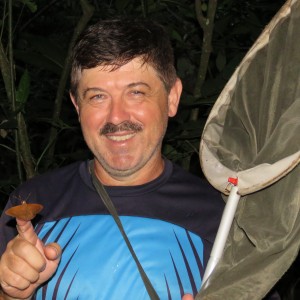
A California native who moved to Honduras in 1993 for the Peace Corps, Robert stayed to make a life there, diving headfirst into the world of tropical birds. He is now considered the country's leading authority on both avifauna and butterflies – a double expert on beautiful flying things. He leads tours for Naturalist Journeys to Panama, Honduras, Texas and Trinidad & Tobago. Robert is the current President of the Pro Nature Honduras Foundation, a small non-profit which promotes nature-based sustainable tourism and environmental education. He is also the co-founder of the Honduran Ornithological Society. He has authored two editions of the "Guide to the Birds of Honduras." He and his partner Olivia hope to publish the "Guide to the Butterflies of Honduras" sometime in 2022. The couple lives in Emerald Valley where they protect 50 acres of rich mid-elevation rainforest and are working to install a nature center with their foundation.
Other trips with Robert Gallardo
-
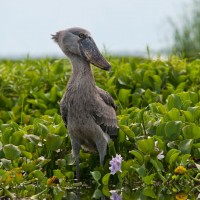 Grand Uganda FULL - Check out Deltas to Dunes: A Botswana-Namibia Safari!July 7 - 24, 2025
Grand Uganda FULL - Check out Deltas to Dunes: A Botswana-Namibia Safari!July 7 - 24, 2025 -
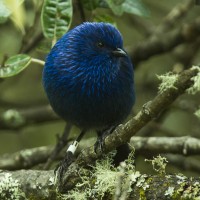 Birds & Mammals of Ecuador's Andes Conservation in Action: Sachatamia, Napo Wildlife Center & Termas de PapallactaNovember 17 - 30, 2025
Birds & Mammals of Ecuador's Andes Conservation in Action: Sachatamia, Napo Wildlife Center & Termas de PapallactaNovember 17 - 30, 2025 -
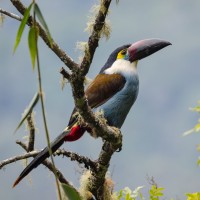 Birding from Bogota A Short & Sweet Colombia TourDecember 6 - 12, 2025, w/Chingaza National Park extension
Birding from Bogota A Short & Sweet Colombia TourDecember 6 - 12, 2025, w/Chingaza National Park extension -
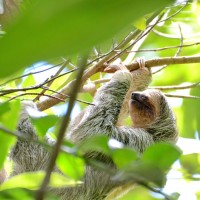 Panama: Birds & MammalsFebruary 20 - 28, 2026
Panama: Birds & MammalsFebruary 20 - 28, 2026 -
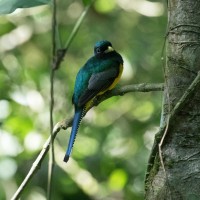 Belize: Three Great LodgesMarch 14 - 24, 2026
Belize: Three Great LodgesMarch 14 - 24, 2026 -
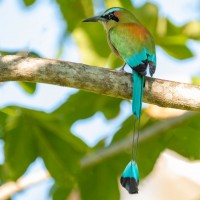 Honduras’ Emerald Valley A Short & Sweet Birding BlitzMay 1 - 7, 2026
Honduras’ Emerald Valley A Short & Sweet Birding BlitzMay 1 - 7, 2026 -
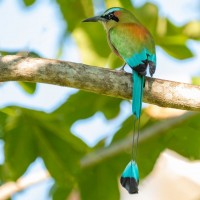 Honduras’ Emerald Valley A Short & Sweet Birding BlitzDecember 1 - 7, 2026
Honduras’ Emerald Valley A Short & Sweet Birding BlitzDecember 1 - 7, 2026
-
Essential Information +
Pace & Protocols +
Packing List +
Suggested Reading List +
Useful Links +
Photo credits: Banners: Howler Monkey, Copan Ruins, Scarlet Macaw, Montezuma Oropendola, Bare-throated Tiger Heron, Thumbnails: Turquoise-browed Motmot, Violet Sabrewing, Guatemalan Screech Owl, Mantled Howler Monkey Three-toed Sloth, Red-lored Parrot, Bare-throated Tiger Heron, Scarlet Macaw


